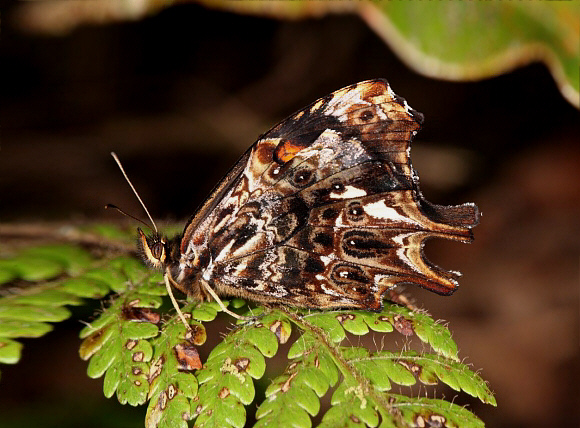
Introduction
There are about 1150 known species of Satyrinae in the neotropical region. About 600 of these are placed in the subtribe Pronophilina – a diverse group of high altitude cloudforest species, all of which are confined to the neotropics. The vast majority are purely Andean, but 4 species are known from the Atlantic cloudforests of Brazil, and 6 species are endemic to Guatemala, Costa Rica or Mexico. More oddly there is one genus Calisto that is found only in the Caribbean, on Cuba and Hispaniola.
In addition to having unique wing venation, Daedalma are characterised by their long palpi, hairy eyes, and very short antennae. Most species possess a pair of lobed tails on the hindwings, which in all species have a protruding costal margin. The forewing apex is angled in all species. The marbled pattern on the hindwings is unique to Daedalma. The upper surface of the wings is blackish-brown, marked in several species with a diagonal orange or whitish patch on the forewings. In vertex the forewing has an irregularly shaped broad orange diagonal bar and a vague orange sub-apical bar.
The 2011 Daedalma revision by Pyrcz lists 11 species, distributed across the Andes from Colombia to the El Tama range in Venezuela, and south to Bolivia.
There are 6 Daedalma species found in Peru – boliviana, fraudata, inconspicua, adamsi, dinias and vertex. The latter 3 are endemic to Peru.
Daedalma vertex has 2 subspecies – vertex and milleri.
Habitats
This species is localised and uncommon in cloudforest at elevations above 2600m and often above 3000m. It inhabits naturally disturbed areas dominated by the larval foodplant Chusquea.
Lifecycle
The lifecycle of vertex is unknown, but is likely to be similar to that of Daedalma rubroreducta as follows: The eggs are laid in a batch centrally on the underside of a leaf of Chusquea bamboo. The newly hatched larvae are dull olive green at first, becoming reddish-brown later in the instar. They feed gregariously, side by side. When transferring to feed on another leaf they proceed in a head-to -tail procession. The fully grown larvae disperse and feed solitarily. The mature larva is mottled and marbled in olive and brown, and has the appearance of a mossy stick with a squarish cross-section. The head is flattened and squarish, and possesses a pair of prominent clubs. As with all Satyrine larvae the tail is pronged. The pupa has the appearance of a twisted, mouldy decaying leaf, and is a remarkably beautiful object, marbled in green and brown, with projecting palpi, a thoracic dorsal knob, and a series of paired dorsal protuberances on the abdomen.
Adult behaviour
Both sexes are reluctant to fly but can occasionally be encountered flying along forest trails, or settled on ferns or other low herbage.
